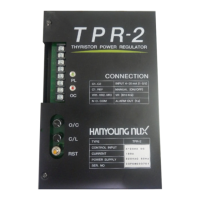Internal Structure
How to operate
Wiring Diagram Function Explanation
Function Explanation
25 ~ 70 A
Detecting Over-current Function
ON-OFF Control Method
Continuous Control Method
Constant Voltage (Current) Control Method
Constant Power Control Method
100 ~ 200 A
Temperature Controller for Current Output
Thyristor Power Regulator is operating as
following the signal of 4~20 mA DC from the above
This is not followed the method of the relay output which is used up to
the date. This controller outputs the current of 4 ~ 20 mA DC(Internal
Standards) from the setting value of 5 %.
For example
Temperature Controller for 400
If Setting value = 300
It outputs 20 mA DC up to 280
It outputs 12 mA DC up to 300
It outputs 4 mA DC beyond 320
Our Thyristor power regulator employs electronic over-current circuit. In
the case of flowing over-current in the load, as the detecting over-
current circuit is operating, it stops the gate s signal of the control
element, Thyristor, so that the control element,
Thyristor, becomes “OFF.” At this moment, the front over-current
indicator (OC) of the Thyristor power regulator will be lighting. At this
time, by using the alarm contact, you can use the alarm.
Control Method of Thyristor Power Regulator
By the function of Temperature Controller, it can be divided into two ways, ON-
OFF control method and continuous control method.
By using Thyristor power regulator, a temperature controller device can be used
ON-OFF, continuous control or etc. as only converting the input signal of the
gate. Specially, for an electric furnace which contains high thermal capacity or a
control target which is slowly responded, these methods are suitable.
This method is operating when the current temperature is higher or lower the
setting temperature of the controller and it has a simple structure and economical.
However, the operating area is ON-OFF around the setting value so there is the
up and down occurrence by 2-position operation.
To eliminate the occurrence, we need the fact that if the adjusting sensitivity
becomes narrower then there might be the output’s tremble occurrence or it can
be affected by the noise and if the adjusting sensitivity, Dead Band, becomes
wider, the accuracy can be a problem. But, if the width of the up and down,
cycling, occurrence is within the allowable temperature width then ON-OFF
control can be applicable.
The proportional operation is the basis as the continuous control of electrical
furnace and this is the method which is applying the proportional outputs to the
heating element in the furnace in accordance with the deviation signal magnitude
after comparing the temperature in the furnace with the setting value.
If applying only the proportional control (P), theoretically, there is unavoidable
error by the circuit constant. To prevent this error and to obtain more accurate
control, it is more effective to employ the integral operation (I) or to make the
response time faster, it is more to use the differential operation (D). Therefore, P.I
or P.I.D control is generally used.
For the case of doing an individual or batch control the temperature of the target
which the temperature detection is difficult, generally, the constant voltage control
is employed. This method controls the average value of the voltage or the
effective value which applies to the furnace constantly with ignoring many little
disturbances about the controller. Therefore, instead of getting the return signal
from the controller of the temperature detection type, detect the furnace°Øs
temperature and then make it as the signal of the power regulator it becomes the
constant voltage control.
At this time, you have to decide whether you use the average value or the
effective value to control. Since the heating effect of the heater is controlled by
the effective power, the latter one looks more suitable. However, generally, the
detection of the effective value of the voltage in comparison with the detection of
the average value it requires more high technology so it costs more. Therefore,
for the target which is not required the high accuracy, normally, the average value
control is used.
Unlike the purely resistive heating element, the resistances of the silundum
heating element and the molybdenum heating element are changed steeply
according to the operating or elapse of the time. Even though using the control
method which is mentioned before, it remarkably shortens the element’s lifetime
as it becomes overpowered or underpowered. The constant power control is to
solve for this faulty matter. To control the constant power, detect the effective
power which can mean to obtain it by multiplying the apparent power and the
power factor as using non-linearity of the combined circuit after detecting the two
elements of the effective voltage as well as the effective current.
Therefore, it is the same way of the general control method except installing the
above power detector into the front of the gate control area from the constant
power control device.
It outputs the power like the bottom
4 mA 0 %, 8 mA 25 %, 12 mA 50 %, 16 mA 75 %, 20 mA 100 %
refer to the picture 1

